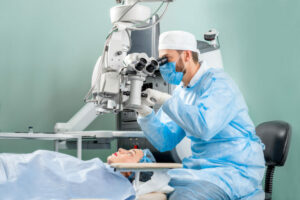
From wrinkles to worsening sight, change is inevitable as you age. Like any other part of the body, your eyes are not immune to the effects of time, and your vision can be affected in a variety of ways.
While age-related eye changes are normal, that doesn’t mean you have to just accept reduced vision quality. Treatments are available that can rewind time and renew your visual experience.
Keep reading to learn more about age-related vision changes, including cataracts!
What are Age-Related Vision Changes?
Simply put, age-related vision changes are alterations to your eyesight that occur as a result of the natural aging process. While your eyes are fully developed by the time you reach your twenties, you can still experience vision changes for a range of reasons, including aging.

Age-related vision changes typically begin when you are in your forties or older. At that point, it is common for you to notice that your vision isn’t as strong as it used to be.
As you get older, the different structures of your eye can change. For example, your lens can become less flexible over time, leading to presbyopia or age-related farsightedness.
The functioning of different structures can also decline over time. This is why you become more susceptible to developing certain eye diseases with age.
In combination with aging, certain factors can also increase your likelihood of experiencing vision changes. This includes UV exposure and smoking.
There are many types of age-related vision changes. All of the following are associated with aging:
- Presbyopia (age-related farsightedness)
- Glaucoma
- Age-related macular degeneration (AMD)
- Cataracts
What Are Cataracts?
Cataracts are one of the most prevalent types of age-related vision changes. Over twenty-four million people in the United States are affected by cataracts.

According to the American Academy of Ophthalmology, about half of Americans have experienced cataracts by the time they reach seventy-five. A cataract is when the lens of your eye becomes cloudy.
As a result, light is not able to pass through the lens properly. This can impair your vision in many ways.
While cataracts can affect a person of any age, they are typically a result of the aging process. The lens is filled with proteins, and over time, these proteins begin to break down.
When they clump together, this is what actually forms the clouded area. Cataracts develop gradually.
It can take years for a cataract to develop completely. Until then, you may not even be aware that you have one.
How Do You Know if You Have a Cataract?
Because cataracts often involve little to no symptoms at first, they can quietly remain in the background and go undetected. However, they will eventually have an undeniable effect on your vision as they develop and the clouded area grows.

Common cataract symptoms include:
- Blurry vision
- Double vision
- Halos and starburst around light sources
- Trouble driving at night
- Light sensitivity
- Colors appearing dull or faded
The only way to know for sure whether you have a cataract is to get a thorough examination from an eye doctor. During a standard eye exam, your doctor will closely evaluate your lens for signs of cataracts.
Every day, more people learn that they have a cataract. This is not to worry, though, as cataracts are treatable.
When is Cataract Surgery Necessary?
Cataract surgery is not always necessary right away. Being diagnosed with a cataract does not mean that your next step is to schedule surgery.
Because cataracts develop so slowly, there is no need to intervene if it is not affecting you much or at all. You can live with a cataract for years and still do all the things you want to do without it bothering you.
Cataract surgery is typically only recommended when a cataract is getting between you and the life you want to live. Cataracts can make everyday activities like reading, doing laundry, and driving difficult.

If you’ve noticed that tasks that used to be easy have become quite an ordeal due to vision challenges, then cataract surgery can return your vision to what it used to be or make it even better.
Cataract surgery is a routine, quick procedure. Millions are performed every day.
Your cataract surgeon will remove your cataract by breaking up your natural lens with a laser and inserting a clear new lens where it used to be. This artificial lens, referred to as an intraocular lens or IOL, is permanent.
By electing for an advanced lens, you can even reduce your need for glasses. With the cataract gone, the effects are immediate, although it can take a few weeks for your vision to reach its optimal clarity.
Then you can enjoy your life to the fullest, thanks to cataract-free vision.
Are you experiencing any vision changes, whether from a cataract or anything else? Schedule an appointment at Hayden Vision in Evansville, IN, today!
